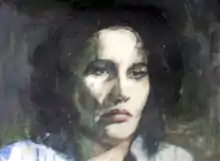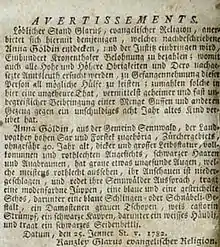Anna Göldi
Anna Göldi (also Anna Göldin or Anna Goeldin, 24 October 1734 – 13 June 1782)[1][2] was an 18th-century Swiss woman who was the last person to be executed in Europe for witchcraft.[3] Göldi, who was executed by decapitation, has been called the "last witch" in Switzerland.
Anna Göldi | |
|---|---|
 Artist depiction of Anna Göldi | |
| Born | 24 October 1734 |
| Died | 13 June 1782 (aged 47) Glarus, Republic of the Swiss |
| Cause of death | Decapitation |
Biography

A native of Sennwald, Anna Göldi arrived in Glarus in 1765. When she was 31, Göldi was impregnated by a mercenary, who left Switzerland before Göldi gave birth.[4] Göldi's baby died the first night it was born (something not uncommon due to the high infant mortality of the era).[4] She was pilloried and sentenced to six years of house arrest.[4] Göldi subsequently escaped and found employment with the Zwicky family, and had a son with Melchior Zwicky, though they were not married.[4]
Göldi began working as a maid for the Tschudi family in 1780.[4] Jakob Tschudi reported her for having put needles in the bread and milk of one of his daughters, apparently through supernatural means.[4] Göldi at first escaped arrest, but the authorities of the Canton of Glarus advertised a reward for her capture in the Zürcher Zeitung on 9 February 1782. Göldi was arrested and, under torture, admitted to entering in a pact with the Devil, who had appeared to her as a black dog. She withdrew her confession after the torture ended, but was sentenced to execution by decapitation. The charges were officially of "poisoning" rather than witchcraft, even though the law at the time did not impose the death penalty for non-lethal poisoning.[5]
During her trial, official allegations of witchcraft were avoided, and the court protocols were destroyed. The sentence does therefore not strictly qualify as that of a witch trial. Still, because of the apparent witchhunt that led to the sentence, the execution sparked outrage throughout Switzerland and the Holy Roman Empire.
The sentence was described at the time by historian August Ludwig von Schlözer as a judicial murder ("the murder of an innocent, deliberately, and with all the pomp of holy Justice".[6])
Legacy
In 1982, Eveline Hasler published a book about Anna Göldi, since translated into English as Anna Goeldin – The Last Witch. A Novel. In 1991, Gertrud Pinkus released a film based on Hasler's book.[7]
Exoneration
On 20 September 2007, the Swiss parliament decided to acknowledge Anna Göldi's case as a miscarriage of justice. Fritz Schiesser, as the representative for Glarus in the Swiss parliament, called for Anna Göldi's exoneration, which was granted 226 years after her death, on 27 August 2008 on the grounds that she had been subjected to an "illegal trial".[5] Apparently, Göldi's married employer abused his power after she had threatened to reveal their affair.[5][8]
Memorial
The Swiss town of Glarus unveiled a memorial for Göldi in 2014. The memorial, consisting of two permanently lit lamps on the side of the Glarus court house, is intended to draw attention to violations of human rights that occur in the world today, as well as Göldi’s story.
A plaque on the building's facade explains the lamps' significance. "The memorial is an expression of atonement for the injustice that took place here. It will be an eternal light for Anna Göldi."[9]
On August 20, 2017, the Anna Göldi Museum was opened in the Hänggiturm building.[8][4]
In popular culture
The life of Göldi has been the subject of a musical, with Göldi performed by Masha Karell.[4][10]
Musically, the life of Göldi was captured by the doom metal, psychedelic rock band 1782 in their single "She Was a Witch" [11]
See also
Bibliography
- Hasler, E. (2013) Anna Goeldin -- The Last Witch. A Novel Trans. Mary Bryant. Ed. Waltraud Maierhofer. Lighthouse Christian Publishing. ISBN 1482659492
References
| Wikimedia Commons has media related to Anna Göldi. |
- Swiss Historic Lexicon article about Anna Göldi (not available in English) "Göldi [Göldin], Anna". hls-dhs-dss.ch. 23 September 2005.
- The Anna Göldi Foundation notes that while the date of her sentencing and death is commonly cited as June 18, the recorded date of her sentencing by the protocol of the Evangelical Council is June 6, and her execution is given as June 13. "Anna Göldi". Anna Göldi Stiftung. Retrieved 16 August 2016.
- ""Last witch in Europe" cleared". swissinfo.ch. Retrieved 21 June 2017.
- Gotsch, Lars (August 21, 2017). "Anna Göldi was like a wild horse, impossible to catch". Swissinfo.
- "Last witch in Europe cleared". August 27, 2008.
- Ermordung eines Unschuldigen, vorsätzlich, und so gar mit allem Pompe der heil. Justiz, (von Schlözer, p. 273)
- "Analyse: Anna Göldin, Die letzte Hexe". regionalgeschichte.net. Retrieved 16 August 2016.
- "Anna Goeldi's story and exoneration". Online edition of the BBC News. September 20, 2007. Archived from the original on 15 October 2007. Retrieved 2007-09-20.
- "Anna Göldi's memorial". Online edition of the SwissInfo. Retrieved 2014-06-15.
- "Darsteller" (in German). 2017. Archived from the original on August 31, 2017. Retrieved August 30, 2017.
Masha Karell als Anna Göldi
- https://1782doom.bandcamp.com/releases